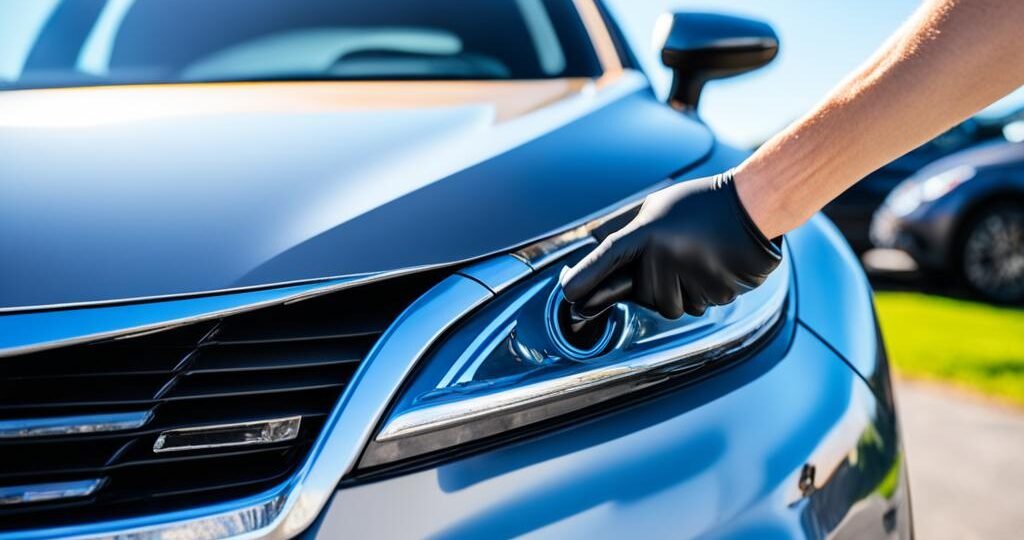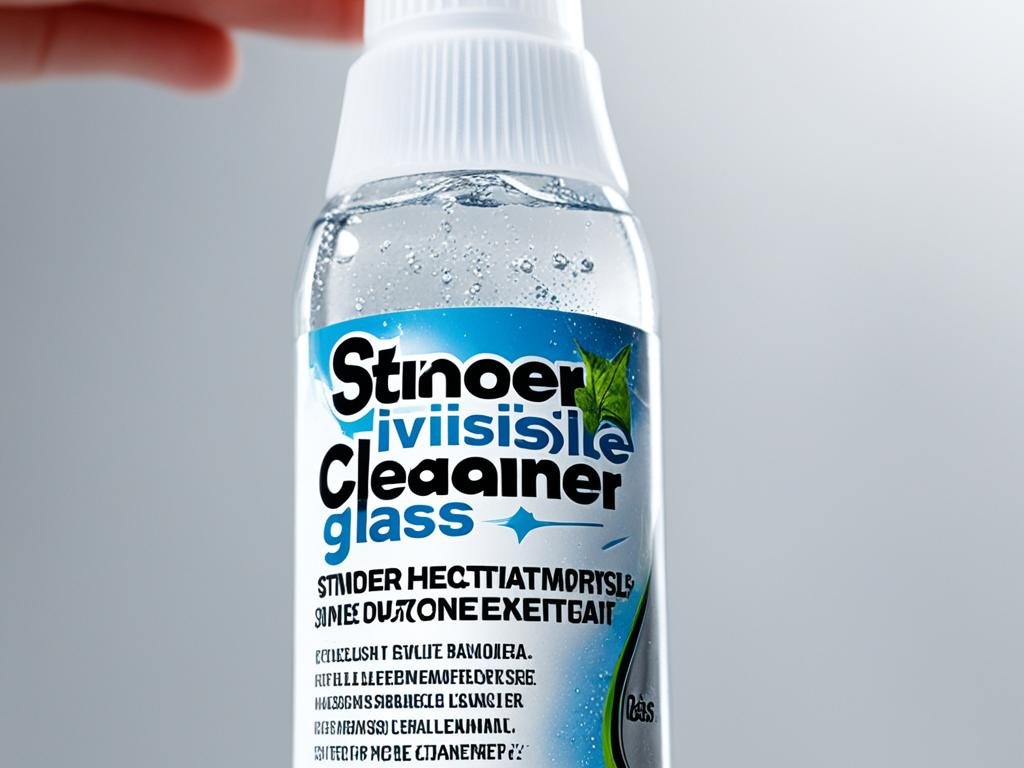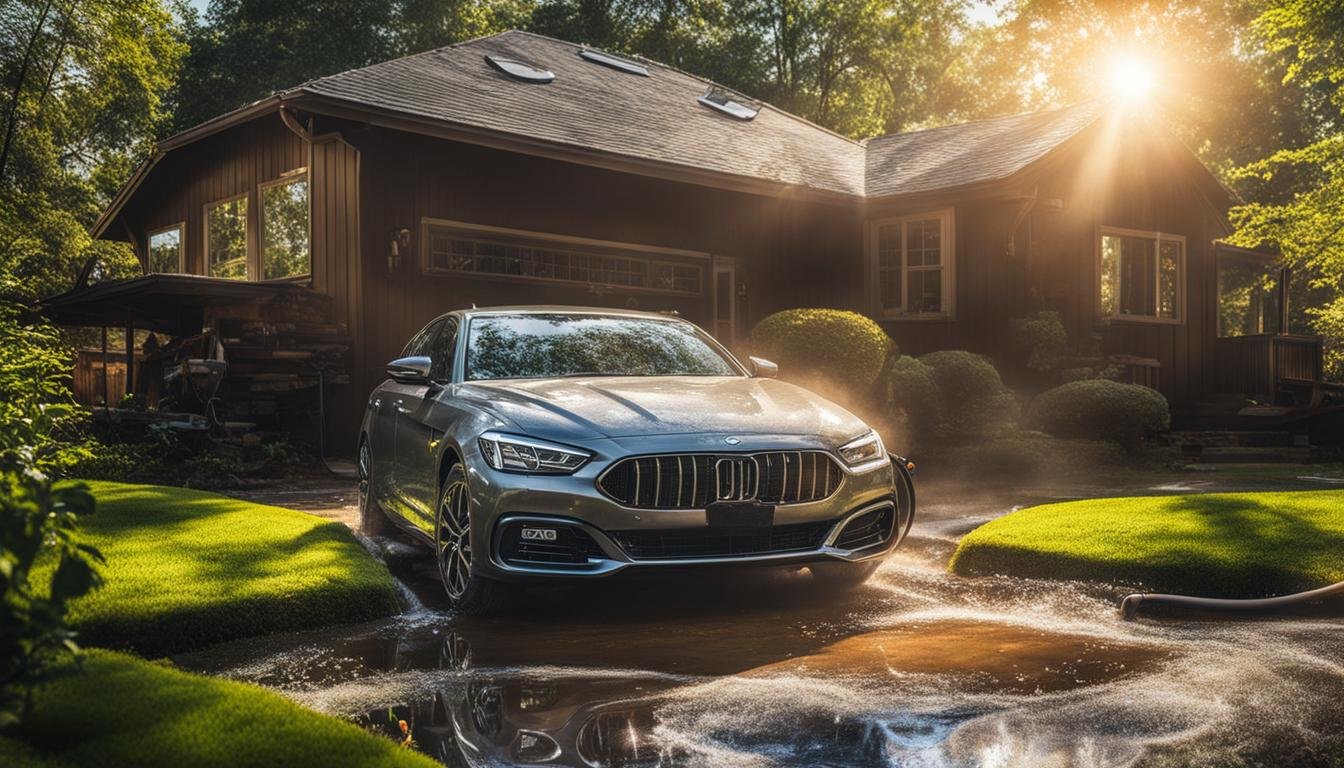How to Perform a Mobile Ceramic Coating Application
April 11, 2024 | by Rosie Dazzlers

Serving Norfolk and Oxford counties, we bring the shine to you. From sedans to SUVs, experience unmatched convenience and quality right at your doorstep. Trust us to make your vehicle dazzle. Call now and let your car shine!
Key Takeaways:
- Mobile ceramic coatings are highly effective paint protectors that can last up to ten years.
- Before attempting a DIY ceramic coating application, proper paint correction and polishing are essential.
- Follow a step-by-step process, including hand washing, iron removal, clay bar treatment, and machine polishing.
- Finish with an isopropyl alcohol wipe-down before applying the ceramic coating.
- Allow the ceramic coating to cure for at least 48 hours without water contact or washing.
Continue reading for a detailed guide on how to perform a mobile ceramic coating application on your vehicle. Mastering this process will help you protect your car’s paint and achieve a stunning, long-lasting shine.
Step 1: Hand wash your vehicle
The first step in the mobile ceramic coating application process is to thoroughly hand wash your vehicle. Start by using a degreaser to remove any paint surface grime. Follow this by claying the vehicle to remove any residual contaminants. Finally, rinse the vehicle off completely to ensure a clean surface for the next steps.
Step 2: Spray Iron Remover (IronX)
After rinsing your vehicle, spray an iron remover, such as IronX, onto the entire car. Make sure to cover all surfaces, including glass, paint, and rims. The iron remover will effectively eliminate any iron contamination present on the surface of the vehicle. Allow the product to dwell for about five minutes, then rinse the vehicle again to remove any residual IronX product.
Step 3: Clay bar
Next, use a clay bar while the vehicle is still wet to remove any remaining contamination from the paint surface. The clay bar will restore the paint to a smooth-as-glass finish. Once you’ve finished claying, rinse the vehicle thoroughly to remove any residual clay residue.
Step 4: Super Dry
After rinsing the vehicle, it’s crucial to dry it thoroughly. Use a clean microfiber towel or a blow-dryer to ensure that there is no water left on the surface. Drying the vehicle completely is essential to prepare it for the next step.
Step 5: Machine Polish
Using a dual action buffer, machine polish the vehicle to level out the paint and remove any light surface imperfections. It is recommended to use a light polishing pad with a finishing polishing product. For vehicles with more extensive swirl marks or scratches, a full paint correction with multiple polishing stages may be necessary.
Step 6: IsoProp Alcohol (Oil & Polish Eraser)
To remove any polishing oil residue from the vehicle’s surface, apply an automotive oil remover, such as isopropyl alcohol, to a brand new microfiber towel. Wipe the entire vehicle with the towel to ensure the paint is free from any contamination.
Step 7: Ceramic Coating application
Once the vehicle is clean and free from water or contamination, it’s time to apply the ceramic coating. Work in small sections and apply the coating using circular or cross hatch motions. Let the coating “sweat” on the paint for about 45 seconds, then remove it with a new microfiber towel. After applying the coating to the entire vehicle, allow it to cure for at least 48 hours without any water contact or washing.
Now that you have all the steps laid out, you can confidently perform a mobile ceramic coating application for your vehicle. Remember to follow the process precisely to achieve the best results. Protect and enhance your car’s paint with this professional application method.
Trust Rosie Dazzlers Mobile Auto Detailing to provide exceptional quality and convenience when it comes to mobile ceramic coating applications. Contact us today to schedule an appointment and experience the incredible shine and protection that ceramic coatings offer!
Step 1: Hand wash your vehicle
In order to ensure a clean and prepared surface for the ceramic coating application, it is crucial to start with a thorough hand wash of your vehicle. This step removes any dirt, grime, or contaminants that may hinder proper adhesion of the ceramic coating.
Here’s how you can effectively hand wash your vehicle:
- Start by rinsing the entire vehicle with water to remove loose dirt and debris.
- Using a high-quality car wash shampoo and a microfiber mitt, gently scrub the vehicle’s surface in a back-and-forth motion. Be sure to cover all areas, including the hood, roof, doors, and bumpers.
- Pay extra attention to areas with heavy dirt or grime buildup, such as the lower parts of the vehicle and the wheel wells.
- Rinse off the car wash shampoo thoroughly, ensuring that no residue is left behind.
Hand washing your vehicle not only removes surface dirt, but it also provides an opportunity to inspect the paint for any imperfections or areas that may require additional attention before the ceramic coating application.
Removing Paint Surface Grime
In some cases, regular hand washing may not be enough to remove stubborn grime or contaminants from the paint surface. If you encounter such issues, it is recommended to use a degreaser specifically designed for automotive applications.
When using a degreaser:
- Follow the manufacturer’s instructions for the proper dilution of the degreaser.
- Apply the diluted degreaser to the affected areas, using a microfiber cloth or sponge.
- Gently agitate the grime or contaminants, allowing the degreaser to break them down.
- Rinse off the degreaser thoroughly, ensuring that no residue remains on the paint surface.
Once you have removed any paint surface grime, you are now ready to proceed to the next step of the ceramic coating application process.

Why is hand washing important?
Hand washing your vehicle before applying a ceramic coating is crucial for several reasons:
“Hand washing removes surface contaminants that may hinder the bonding and durability of the ceramic coating. It also allows for a closer inspection of the paint surface, ensuring that any imperfections are addressed before coating.”
By starting with a clean and properly washed vehicle, you set the foundation for a successful and long-lasting ceramic coating application.
Step 2: Spray Iron Remover (IronX)
After the vehicle has been rinsed, it is important to spray an iron remover, such as IronX, onto the entire car, including the glass, paint, and rims. This product will effectively eliminate any iron contamination present on the surface of the vehicle, ensuring a clean and smooth finish.
Iron contamination is a common issue on vehicles, particularly those exposed to road grime and industrial fallout. It manifests as tiny orange or brown particles embedded in the paintwork, resulting in a rough texture and compromising the overall appearance of the vehicle.
IronX is specifically formulated to dissolve and remove these iron particles, restoring the surface to its original pristine condition. This step is crucial in the mobile ceramic coating application process, as it ensures that the coating adheres properly to the vehicle’s surface, maximizing its durability and effectiveness.
Once IronX has been sprayed onto the vehicle, it is recommended to let it dwell for at least five minutes. During this time, the iron remover chemically reacts with the iron contamination, breaking it down and loosening its grip on the paintwork. After the dwell time, the vehicle should be rinsed thoroughly to remove any residual IronX product and loosened iron particles.
By using an iron remover like IronX, you can effectively eliminate iron contamination and achieve a prepared surface ready for the next steps of the ceramic coating application process.
Step 3: Clay bar
Now that the vehicle has been thoroughly washed and rinsed, it’s time to tackle any remaining contamination on the paint surface. This step is crucial for achieving a smooth, flawless finish. We recommend using a clay bar to effectively remove any embedded dirt, road grime, or other impurities.
Clay bars are specifically designed to gently lift and pull out contaminants from the paint, leaving behind a clean and smooth surface. They work by creating friction between the clay and the paint, effectively grabbing onto any particles and pulling them away.
To use a clay bar, simply follow these steps:
- Ensure the vehicle is still wet from the rinse.
- Take a small piece of clay and knead it in your hands until it’s pliable.
- Spray a detailing spray or lubricant onto the clay and onto the painted surface.
- Gently glide the clay bar over the lubricated area using light pressure.
- Continue working in small sections, folding and reshaping the clay as needed to expose clean surfaces.
- Check the clay often to ensure it’s picking up contaminants. If it becomes dirty or discolored, knead it or discard and use a new piece.
After claying the vehicle, rinse it off completely to remove any residue and inspect the paint surface. You should notice a significant improvement in the smoothness and cleanliness of the paint.
Remember, clay bars are abrasive and should only be used when necessary. Overuse or excessive pressure can cause damage to the paint. If you’re unsure about using a clay bar or have concerns about your specific vehicle’s paint, consult a professional.
By incorporating clay bar into your mobile ceramic coating application process, you’re ensuring that the paint surface is free from contamination and prepared for maximum adhesion of the ceramic coating.
Step 4: Super Dry
Once the vehicle has been rinsed, it is crucial to ensure that it is completely dry before proceeding to the next step. Properly drying the vehicle prevents water spots and streaks from forming on the surface, giving it a pristine finish.
Using a Drying Cloth
One method to dry the vehicle is by using a high-quality microfiber drying cloth. Microfiber towels are incredibly absorbent and gentle on the paint, making them ideal for vehicle drying. Simply gently glide the cloth over the surface of the vehicle, absorbing any remaining water droplets.
When using a drying cloth, it is essential to use a clean and soft cloth to minimize the risk of scratching the paint. Additionally, ensure that the cloth is free from debris or contaminants that can potentially cause damage to the vehicle’s finish.
Utilizing a Blow-Dryer
Another effective method for vehicle drying is using a blow-dryer. This method is particularly useful for drying areas that are difficult to reach or where water tends to accumulate, such as side mirrors, door handles, and crevices.
When using a blow-dryer, set it to a medium heat setting and hold it at least 12 inches away from the surface of the vehicle. Move the blow-dryer in a sweeping motion to evenly distribute the heat and dry the area thoroughly. Be cautious not to direct the heat at one spot for too long, as it may cause damage to the paint.
Benefits of Proper Vehicle Drying
Ensuring that the vehicle is completely dry before moving on to the next step of the ceramic coating application process is crucial for several reasons:
- Prevents water spots: By removing all moisture from the surface, you eliminate the risk of water spots forming and leaving unsightly marks on the paintwork.
- Avoids streaking: Properly drying the vehicle prevents streaking, ensuring a flawless finish.
- Prevents towel-induced scratches: Using a clean microfiber towel minimizes the risk of introducing scratches or swirl marks to the paint.
By taking the time to dry the vehicle thoroughly, you set the foundation for a successful ceramic coating application and achieve a professional-grade finish.
Step 5: Machine Polish
After completing the previous steps, it’s time to address any paint imperfections and achieve a flawless surface. Machine polishing using a dual action buffer is the ideal method to level out the paint and remove light surface imperfections.
For this step, we recommend using a light polishing pad along with a finishing polishing product. The polishing pad helps to distribute the product evenly and ensure consistent results. Additionally, the finishing polishing product provides the necessary abrasives to remove imperfections without causing any harm to the paint.
If your vehicle has more pronounced swirl marks or deeper scratches, a full paint correction with multiple polishing stages may be necessary. In such cases, it is recommended to seek professional assistance or consult with a trusted detailing expert to ensure the best outcome.
Machine polishing is a delicate process that requires careful attention to detail. It is essential to follow the appropriate polishing techniques, such as using the correct pressure, speed, and movement patterns, to achieve the desired results. Remember, patience and precision are key when machine polishing your vehicle.
Machine polishing is crucial for achieving a flawlessly smooth surface before applying the ceramic coating.
Step 6: IsoProp Alcohol (Oil & Polish Eraser)
In order to achieve a flawless finish on your vehicle, it is crucial to remove any remaining polishing oil residue from the surface. This can be accomplished by using an automotive oil remover, specifically isopropyl alcohol. Isoprop alcohol is known for its effectiveness in eliminating oil and residue, making it an ideal solution for paint preparation.
When using isoprop alcohol, ensure that you have a brand new microfiber towel dedicated solely for this step. This guarantees that the towel is free from any contaminants that could possibly compromise the paint.
Begin by applying a small amount of isoprop alcohol to the microfiber towel. Gently wipe the entire vehicle, paying close attention to areas that are prone to oil buildup, such as door handles, mirror housings, and trunk creases. The alcohol will effectively dissolve any residual oil or polish, leaving the surface clean and ready for the next stage.
“Using isoprop alcohol ensures that we achieve a pristine surface, free from any paint residue or contamination. This step plays a vital role in ensuring the longevity and durability of the ceramic coating.”
We recommend inspecting the surface of the vehicle under proper lighting conditions to ensure that all remnants of oil and polish have been removed.
By meticulously removing paint residue and contamination using isoprop alcohol, you are setting the foundation for a flawless ceramic coating application.
Step 7: Ceramic Coating application
Now that your vehicle is free from any water or contamination, it’s time to apply the ceramic coating. For best results, we recommend working in small sections and applying the coating using either a circular motion or a cross hatch pattern. This ensures an even and thorough application.
To apply the ceramic coating, use a high-quality applicator pad. Apply a small amount of the coating onto the pad and work it into the paint surface. Allow the coating to “sweat” on the paint for approximately 45 seconds to ensure proper bonding.
After the “sweating” period, gently remove any excess coating using a clean, lint-free microfiber towel. It’s important to use a fresh towel to avoid reintroducing any contaminants. Repeat this process until the entire vehicle has been coated.
Once the coating has been applied, it’s crucial to let it cure for at least 48 hours. During this curing time, avoid any water contact or washing of the vehicle to ensure the coating fully bonds to the paint surface. This will maximize its effectiveness and longevity.
FAQ
What is ceramic coating?
Ceramic coating is a highly effective paint protector for vehicles that can last up to ten years. It provides a durable, long-lasting, and hydrophobic barrier that helps protect the paint from UV rays, chemicals, and contaminants.
Can I apply ceramic coating myself?
Yes, you can apply ceramic coating yourself, but it requires proper preparation and technique. It is important to follow the steps for paint correction, polishing, and surface preparation before applying the coating. If you are unsure, it is recommended to seek professional guidance or hire a mobile ceramic coating service like Wings Mobile Detailing.
What is the first step in the mobile ceramic coating application process?
The first step is to thoroughly hand wash the vehicle using a degreaser to remove any paint surface grime. After washing, rinse the vehicle off completely to ensure it is clean and free of any residue.
Why do I need to use an iron remover?
Using an iron remover, such as IronX, helps remove iron contamination from the surface of the vehicle. This step is essential for achieving a clean and smooth surface before applying the ceramic coating.
How do I use a clay bar?
After rinsing the vehicle, use a clay bar while the surface is wet. The clay bar will help remove any remaining contamination and restore the paint to a smooth-as-glass finish. After claying, rinse the vehicle again to remove any residue.
Should I dry off the vehicle after washing?
Yes, it is important to dry off the vehicle completely before moving on to the next step. Use a clean microfiber towel or a blow-dryer to ensure that the vehicle is dry and free from any moisture.
Why should I machine polish the vehicle?
Machine polishing helps level out the paint and remove any light surface imperfections, such as swirl marks and light scratches. It is recommended to use a dual action buffer with a light polishing pad and finishing polishing product for this step.
Why do I need to use isopropyl alcohol?
Isopropyl alcohol, also known as an oil and polish eraser, is used to remove any polishing oil residue from the surface of the vehicle. This step ensures that the paint is free from any oils or contaminants before applying the ceramic coating.
How do I apply the ceramic coating?
Work in small sections and apply the ceramic coating using circular motions or a cross-hatch pattern. Allow the coating to “sweat” on the paint for about 45 seconds before removing it with a new microfiber towel. Apply the coating to the entire vehicle and let it cure for at least 48 hours without water contact or washing.
Source Links
RELATED POSTS
View all



